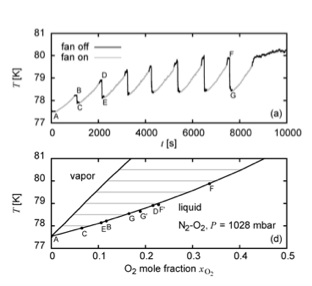Understanding the Differences Between Absolution Calibration Techniques in the Microwave
Submitter:
Turner, David D. — NOAA Global Systems Laboratory
Area of research:
Radiation Processes
Journal Reference:
Science
Microwave radiometers (MWRs) typically measure downwelling radiation between 22 and 60 GHz. The most common geophysical variable derived from these observations are liquid water path and precipitable water vapor. However, if the MWR measures radiation at several frequencies along the 22.2 GHz water vapor line (e.g., from 22.2 to 25.0 GHz) and also several frequencies along the oxygen absorption band (e.g., from 52.0 to 58.0 GHz), the profiles of temperature and water vapor in the boundary layer can be derived. However, the accuracy of all of these retrieved geophysical variables depends critically on the accuracy of the radiometric calibration of the MWR.
Impact
There are two primary methods used to calibrate MWRs: (a) the so-called 'tip-curve' method, wherein data are collected at several elevation angles in homogeneous plane-parallel clear sky conditions and the slope of the signal vs. elevation angle is used to determine the gain of the radiometer; and (b) viewing a blackbody target submerged in a liquid nitrogen (LN2) bath. The tip-curve method is only applicable for channels that aren't too opaque. Thus, the 52-60 GHz channels cannot be calibrated using this method. However, studies by many groups around the world have shown the two calibration methods often do not yield the same calibration values. Maschwitz et al. used data collected at a high altitude site (~5300 m mean sea level) to understand the full error budget in both calibration methods, yet the mystery of what was causing the difference between the two methods remained.
Paine et al. devised a set of laboratory experiments to evaluate the stability of the LN2 bath. They discovered that the LN2 bath entrained oxygen (O2) from the air. Hence, the boiling temperature of the bath rose over time. Surprisingly, the rate of inclusion of O2 into the cryogenic bath, and therefore the bath's true boiling temperature, can be determined by the evaporation rate (i.e., the loss of volume with time) from the bath. Furthermore, in some viewing configurations of the LN2 bath, the evaporation rate can be directly determined from the MWR observations of the bath itself, providing a possible way forward to improve the accuracy of the LN2 calibration.
Summary
While the mystery of why the two calibration methods isn't yet solved, these two publications provide new insights on the differences between the two methods. This should lead to improved calibration in MWRs.


